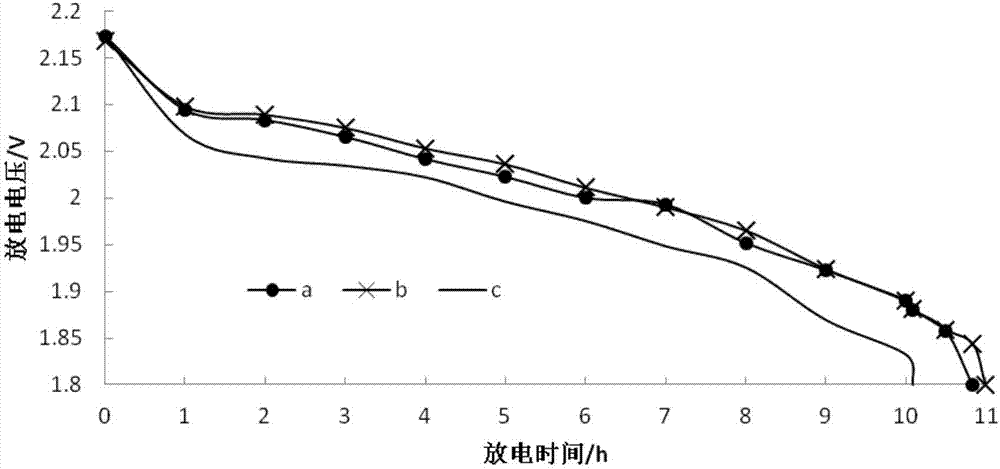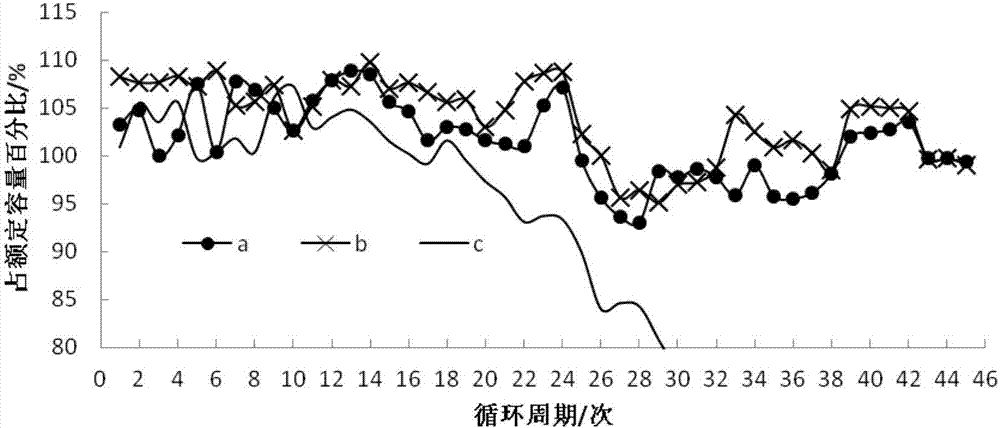High-temperature valve control lead-acid storage battery and preparation method thereof
A lead-acid battery, storage battery technology, applied in lead-acid battery, lead-acid battery construction, secondary battery and other directions, can solve the problems of accelerating the sulfation of the negative electrode, accelerating the corrosion rate of the positive electrode, intensifying the oxygen recombination of the negative electrode, etc. The effect of shrinkage, reduction of water splitting and battery self-discharge, and increase of porosity
- Summary
- Abstract
- Description
- Claims
- Application Information
AI Technical Summary
Problems solved by technology
Method used
Image
Examples
Embodiment 1
[0048] The high-temperature valve-regulated lead-acid battery described above,
[0049] The positive electrode grid alloy components are: Ca0.08%, Sn1.4%, Al0.02%, Ag0.01%, La0.01%, Ce0.01%, Pb as the balance;
[0050] Negative electrode grid alloy adopts lead-calcium-tin-aluminum alloy;
[0051] The main components of the positive active material are: 4BS0.5%, red lead 5%, Bi 2 o 3 0.02%, Lu 2 o 3 0.01%, Na 2 SO 4 0.5%, 1% polypropylene staple fiber, 12% sulfuric acid, 8% battery water, and Barton lead powder as the balance;
[0052] The main components of the negative electrode active material are: Norwegian lignin 0.2%, sodium 2-naphthalene sulfonate 0.3%, ultra-fine barium sulfate 0.3%, Cabot carbon black 0.2%, β-naphthol 0.2%, sulfuric acid 10%, battery 6% water and Barton lead powder as the balance;
[0053] Its preparation method is as follows:
[0054] a) Positive grid casting: First, put 30% lead-calcium-aluminum alloy into the alloy pot, heat up to 420°C±20°...
Embodiment 2
[0061] The high-temperature valve-regulated lead-acid battery described above,
[0062] The positive electrode grid alloy components are: Ca0.1%, Sn1.6%, Al0.03%, Ag0.05%, La0.05%, Ce0.05%, Pb as the balance;
[0063] Negative electrode grid alloy adopts lead-calcium-tin-aluminum alloy;
[0064] The main components of the positive active material are: 4BS2%, red lead 25%, Bi 2 o 3 0.08%, Lu 2 o 3 0.04%, Na 2 SO 4 1.0%, 1% polypropylene staple fiber, 15% sulfuric acid, 10% battery water, and Barton lead powder as the balance;
[0065] The main components of the negative electrode active material are: Norwegian lignin 0.8%, sodium 2-naphthalenesulfonate 0.6%, ultra-fine barium sulfate 0.6%, Cabot carbon black 0.5%, β-naphthol 0.5%, sulfuric acid 12%, battery Water 8%, Barton lead powder is the balance.
[0066] Its preparation method is as follows:
[0067] a) Positive grid casting: First, put 40% lead-calcium-aluminum alloy into the alloy pot, heat up to 580°C±20°C, af...
PUM
 Login to View More
Login to View More Abstract
Description
Claims
Application Information
 Login to View More
Login to View More - Generate Ideas
- Intellectual Property
- Life Sciences
- Materials
- Tech Scout
- Unparalleled Data Quality
- Higher Quality Content
- 60% Fewer Hallucinations
Browse by: Latest US Patents, China's latest patents, Technical Efficacy Thesaurus, Application Domain, Technology Topic, Popular Technical Reports.
© 2025 PatSnap. All rights reserved.Legal|Privacy policy|Modern Slavery Act Transparency Statement|Sitemap|About US| Contact US: help@patsnap.com


